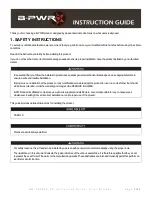
IGNITION SYSTEM
20-4
TROUBLESHOOTING
• Inspect the following before diagnosing the system.
– Faulty spark plug
– Loose spark plug cap or spark plug wire connection
– Water got into the spark plug cap (leaking the ignition coil secondary voltage)
• "Initial voltage" of the ignition primary coil is the battery voltage with the ignition switch turned to ON (The engine is not
cranked by the starter motor).
NO SPARK AT PLUG
Unusual condition
Probable cause (Check in numerical order)
Ignition coil
primary volt-
age
No initial voltage with ignition
switch turned to ON (Other electri-
cal components are normal)
1. An open circuit in Black/White wire between the igni-
tion coil and engine stop relay.
2. An open circuit or loose connection in engine stop
relay related circuit or faulty engine stop relay.
3. Loose or poor contact of the ignition coil primary wire
terminal, or an open circuit in primary coil.
4. Faulty ECM (when the initial voltage is normal with the
ECM connector disconnected).
Initial voltage is normal, but it drops
down to 2 – 4 V while cranking the
engine.
1. Incorrect peak voltage adaptor connections.
2. Cranking speed is too slow. (Battery is undercharged.)
3. No voltage between the Black/White (+) and body
ground (–) at the ECM connector or loosen ECM con-
nector.
4. An open circuit or loose connection in Green/White
wire of the ECM.
5. An open circuit or loose connection in Yellow/Blue
wire between the ignition coil and ECM.
6. Short circuit in the ignition primary coil.
7. Faulty sidestand switch.
8. Loose or poor connection or an open circuit in side-
stand switch White/Green wire.
9. Faulty CKP sensor (measure the peak voltage).
10. Faulty ECM (when above No.1 – 9 are normal).
Initial voltage is normal, but no peak
voltage while cranking the engine.
1. Incorrect peak voltage adaptor connections.
2. Faulty peak voltage adaptor.
3. Faulty ECM (when above No.1 and 2 are normal).
Initial voltage is normal, but peak
voltage is lower than standard
value.
1. The multimeter impedance is too low; below 10 M
Ω
/
DCV.
2. Cranking speed is too slow. (Battery is undercharged.)
3. The sample timing of the tester and measured pulse
were not synchronized. (System is normal if measured
voltage is over the standard voltage at least once.)
4. Faulty ignition coil.
5. Faulty ECM (when above No.1 – 4 are normal).
Initial and peak voltage are normal,
but no spark jumps at plug.
1. Faulty spark plug or leaking ignition coil secondary
current ampere.
2. Faulty ignition coil.
Crankshaft
position
(CKP) sensor
Peak voltage low
1. The multimeter impedance is too low; below 10 M
Ω
/
DCV.
2. Cranking speed is too slow. (Battery is undercharged.)
3. The sampling timing of the tester and measured pulse
were not synchronized. (System is normal if measured
voltage is over the standard voltage at least once.)
4. Faulty CKP sensor (when above No. 1 – 3 are normal).
No peak voltage.
1. Faulty peak voltage adaptor.
2. Faulty CKP sensor.
Summary of Contents for SH300I 2006
Page 54: ...MEMO...
Page 55: ...2 1 2 2 TECHNICAL FEATURES HEATER LESS O2 SENSOR 2 2 UNIT SWING ENGINE LAYOUT 2 3...
Page 58: ...MEMO...
Page 216: ...MEMO...
Page 242: ...CYLINDER PISTON 10 2 CYLINDER PISTON COMPONENT LOCATION...
Page 250: ...MEMO...
Page 270: ...MEMO...
Page 296: ...MEMO...
Page 314: ...MEMO...
Page 394: ...MEMO...
Page 422: ...MEMO...
Page 440: ...MEMO...
Page 456: ...MEMO...
Page 484: ...MEMO...
Page 499: ...24 1 24 24 WIRING DIAGRAMS STD type 24 3 ABS type 24 4...
Page 509: ...MEMO...
















































